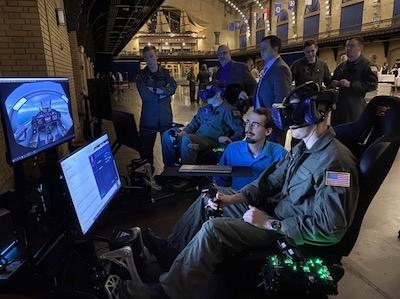U.S. Naval Academy Launches Two Virtual Reality (VR) Trainer Devices
Midshipmen got a 360-degree view of flight training during Aviation Selection Night at the U.S. Naval Academy in Annapolis, Maryland, Jan. 9, marking a new era in technology for prospective flight students.

In a partnership between Chief of Naval Air Training (CNATRA), Naval Air Systems Command (NAVAIR) and Naval Air Warfare Center Training Systems Division (NAWCTSD), the U.S. Naval Academy launched two virtual reality (VR) trainer devices during the event at Dahlgren Hall.
The VR trainers will help prepare Midshipmen selected for flight training in an “early start” concept, said Deputy Commandant for Leadership and Character Development and Senior Naval Aviator Navy Capt. Ryan Bernacchi.
“We are thrilled by the arrival of the Naval Academy’s first two T-6B Texan II VR flight simulators,” Bernacchi said. “Their delivery has generated quite a buzz, and our Midshipman are eager to get in and start to get a feel for what’s coming next for those who are selected for flight training upon graduation.”
Implementing VR trainers is a historic step for the U.S. Naval Academy’s aviation program. The two devices will allow students to experience virtual flight in a T-6B Texan II, the aircraft used during primary flight training for the Navy, Marine Corps, and Coast Guard. The objective is to deliver newly commissioned officers to CNATRA who already possess some familiarity with T-6B procedures and subsequently deliver winged aviators more quickly to the fleet.
“The Naval Academy has always had a robust seamanship training program utilizing training patrol craft and sailboats, but we haven’t had the ability to do any aviation training on the Academy Yard in over 100 years,” Bernacchi said. “I’d like to express a huge thank you to our Air Boss Vice Adm. Dewolfe Miller, Rear Adm. Greg Harris (N98), and Rear Adm. Daniel Dwyer (CNATRA) for bringing cutting edge VR trainers to the Naval Academy.”
The VR trainers, now set up in a classroom at Luce Hall on Academy grounds and already in use, could also provide an opportunity in the future for Academy leadership to look at ways to assess aptitude and motivation for the competitive selection process for Naval Aviation.
In 1911, the Navy’s first airplane was delivered in crates and assembled in Dahlgren Hall, under the supervision of Naval Aviator #1, Lt. Theodore “Spuds” Ellyson. Successful flight operations commenced the next day, and from 1911-1913 the Naval Academy was established as the Navy’s first naval air station. In 1913, NAS Pensacola, Florida, was established and operations shifted south to more favorable winter weather.
This year’s aviation selectees included 275 Midshipmen selected for pilot training and almost 50 selected for naval flight officer training. Upon graduation, these men and women will report to the “Cradle of Naval Aviation” at NAS Pensacola. The majority of aviation selectees then begin Initial Flight Screening, which includes ground school and flight in civil aircraft. However, students with a Power Flight Program waiver, FAA recreational pilot, private pilot, or higher certificate proceed directly to Aviation Preflight Indoctrination with Naval Aviation Schools Command.
CNATRA oversees all undergraduate flight training for the Navy, Marine Corps, and Coast Guard. NAWCTSD is the principal center for research, development, test and evaluation, acquisition, and product support for training systems.
(Image provided with Chief of Naval Air Training news release)
 ANN's Daily Aero-Linx (06.29.25)
ANN's Daily Aero-Linx (06.29.25) ANN's Daily Aero-Term (06.29.25): Gross Navigation Error (GNE)
ANN's Daily Aero-Term (06.29.25): Gross Navigation Error (GNE) Classic Aero-TV: Anticipating Futurespace - Blue Origin Visits Airventure 2017
Classic Aero-TV: Anticipating Futurespace - Blue Origin Visits Airventure 2017 NTSB Final Report: Cirrus SR22
NTSB Final Report: Cirrus SR22 Airborne Affordable Flyers 06.26.25: PA18 Upgrades, Delta Force, Rhinebeck
Airborne Affordable Flyers 06.26.25: PA18 Upgrades, Delta Force, Rhinebeck



